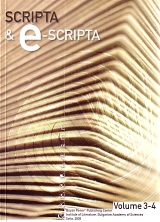Copies of the Book of Revelation of St. John in Festal Collections
Copies of the Book of Revelation of St. John in Festal Collections
Author(s): Iva TrifonovaSubject(s): Literary Texts
Published by: Институт за литература - БАН
Keywords: The Book of Revelation of St. John; Slavonic Cyrillic texts of the Apocalypses; Croatian Glagolhic fragments
Summary/Abstract: The description and the examination of the preserved Slavonic Cyrillic texts of the Apocalypses have so far been focused mainly on the most numerous Russian interpretation copies, on the accepted as textologically earliest Bosnia copies and Croatian Glagolhic fragments. The latest studies are aimed at finding, systematization and research of the preserved South Slavonic copies, which have not yet found their due place in the entire textological history of the book. As a result of this research up to now three versions at the distribution of the text have been known, which differ in structure, purpose and location in the content of the collections where they appear. These are: the interpretational version of the book by Andrey Kesariisky, divided in 24 orations, 72 chapters and 314 verses, distributed mainly amongst the Eastern Slavs; the Bosnia Cyrillic copies, non-interpretational, divided in 72 chapters, and the Serbian copy HM 474, also divided in 72 chapters (the first 5 are written, the rest are noted with an initial); the Croatian Glagolhic texts, separated in 22 chapters by the Latin tradition. In the present article introduced in scientific use is one more unknown up to that moment South-Slavonic tradition of distribution of the text. This is the Bulgarian panegyric version, presented by the Bulgarian copy from the middle of the 14th century, predatonic connected with the East-Bulgarian Tarnovo literature. The revision of the book in the Serbian interpretational copies, kept from the 15th to the 16th century, which is probably a result of the work of the Mount Athos scholars, also has not been object of scientific attention. The purpose is to trace the tradition they reflect on the bases of the lexical data. Thanks to the study of K. Grunberg the lexical exchanges, consequently done between the accepted as initial translation of the book from the 15th century and the editing of the text from the 14th and the 15th century are examined. The translation taken as initial is presented by the Bosnia Cyrillic copies from the 15th century (H), and the editing of the text from the 14th and 15th century – from the earliest Bulgarian copy (MS), the Serbian interpretational copies (PI), the earliest Serbian copy (HM), the Apocalypses of the Miracle New testament and its copy from 1493 (?), supported by the data from the Eastern-Slavonic interpretational copies (NI) and the text from the Ostrojka Bible (O).
Journal: Scripta & e-Scripta
- Issue Year: 2006
- Issue No: 3-4
- Page Range: 285-306
- Page Count: 22
- Language: English
- Content File-PDF

